17.08.2023
National Heritage Week 2023: NUI Chancellor Portrait Gallery
National Heritage Week runs from 12-20th August 2023, and this time of year always gets us thinking about the treasures that we have at 49 Merrion Square.
This year, we thought we might tell you a little bit about our portrait gallery of NUI chancellors, as well as the artists who painted them. Our five chancellors have lead NUI through more than a century of revolution and innovation, of war and peace. It is impactful to think of how buildings like No.49, and institutions like NUI, have withstood these times and remain today as strong as ever.
A wonderful resource in researching this piece was the Dictionary of Irish Biography
DIB is wonderful resource as profiles of significant figures in Irish history are available online.
-
Archbishop William J. Walsh, portrait by Leo Whelan
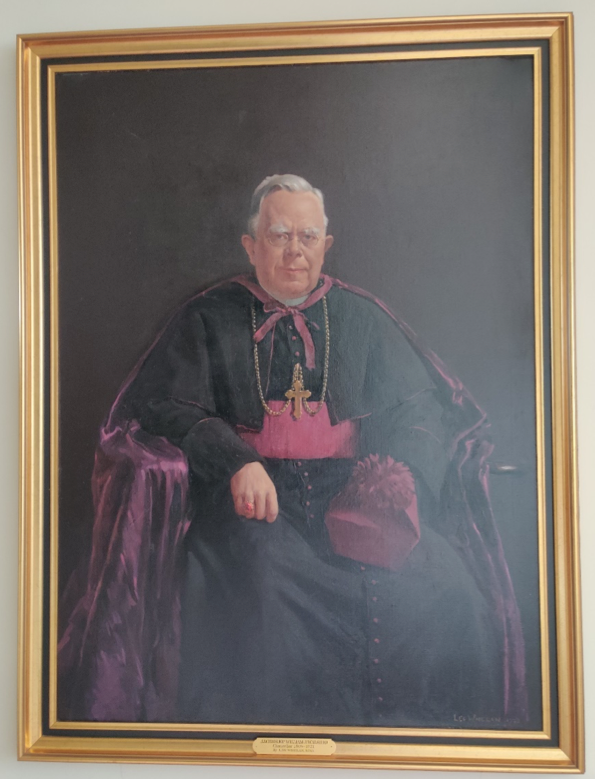
Archbishop William J. Walsh,
portrait by Leo Whelan.
Click to enlarge image.Born in Dublin in 1841, William J. Walsh was a theologian, clergyman, activist and scholar. He studied at the Catholic University under Cardinal Henry Newman, going on to undertake clerical studies at St Patrick’s College, Maynooth, where he would later hold the position of Professor of Theology.
In 1908, Archbishop Walsh became the first chancellor of the National University of Ireland. The years following were a time of great political upheaval both nationally and internationally, as World War One, the 1916 Rising and the War of Independence all made their indelible mark on history.
Through that time, Archbishop Walsh was a stalwart and reliable leader for NUI in its nascency, though from 1915, he was limited by illness and declining health. In April 1921, he passed away, leaving behind a legacy of advocacy – for nationalism, for the homeless, for educating the young people of Ireland, for hunger strikers and for political prisoners.
-
Leo Whelan
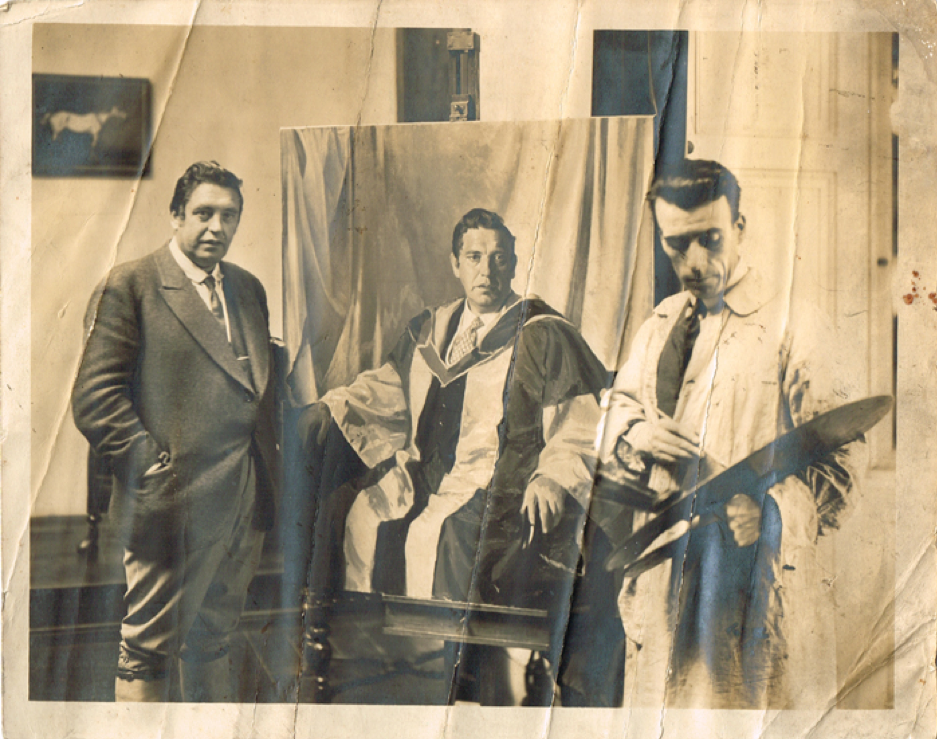
(image courtesy of the National Concert Hall, Dublin,
where the portrait is on display)
Click to enlarge image.Leo Whelan was born in Dublin in 1892. Educated at Belvedere and the Dublin Metropolitan School of Art (under William Orpen’s tutelage), Whelan was a member of the Royal Hibernian Academy. Renowned for his portraits, he painted many prominent figures in Ireland from revolutionaries such as Michael Collins, Liam Mellows and Rory O’Connor to the tenor John McCormack. He lived in Dublin at the hotel owned by his family at 65 Eccles Street, until his death in 1956.
-
Éamon de Valera, portrait by Thomas Ryan
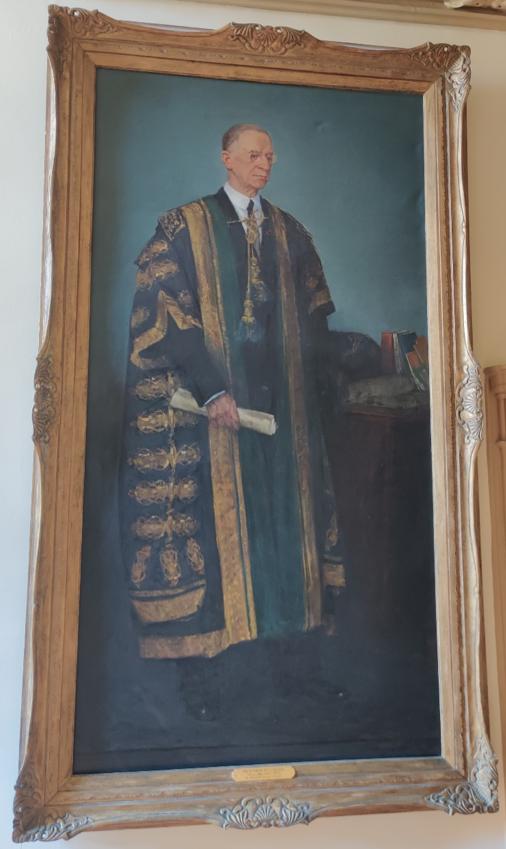
Éamon de Valera,
portrait by Thomas Ryan
Click to enlarge image.Eamon de Valera was born on October 14, 1882 in New York City to an Irish mother and a Spanish father. When his father died in 1885, he was sent to live with his mother's family in Bruree, County Limerick, Ireland. He received his education at Blackrock College and the Royal University in Dublin. After his graduation in 1904, he taught mathematics.
In twentieth century Irish history, de Valera is a prominent presence. His involvement at the very heart of the emergence of the Irish Free State and later of the new Irish nation as defined in Bunreacht na hÉireann, (the Constitution of 1937) is well documented. He narrowly escaped execution after the Easter Rising in 1916. He was appointed Chancellor of the National University of Ireland after Archbishop Walsh’s death, “on the eve of the treaty split” (Fanning, “De Valera, Éamon ('dev’)”). He spent the early part of his chancellorship as a fugitive during the Civil War. His chancellorship, like that of Archbishop Walsh, ended when he died, in 1975.
In 2021, as part of NUI’s programme of events to mark the Decade of Centenaries, in collaboration with the Dublin Institute of Advanced Studies, NUI hosted a series of Dev Talks. which reassessed De Valera’s legacy.
Talks are available to view online here: https://www.nui.ie/DevTalks/
Thomas Ryan
Thomas Ryan was born in Limerick in 1929. He studied at the Limerick College of Art and the National College of Art and Design, where he studied under Seán Keating. Throughout his career, he painted iconic figures such as Patrick Hillery, de Valera (as seen above) and Ronnie Delany, as well as a then-unknown 5-year old Sinéad O’Connor. His famous works also include ‘GPO, 1916’ and ‘Flight of the Earls’. He was president of the Royal Hibernian Academy from 1982 to 1992. He passed away in September 2021.
-
Thomas Kenneth Whitaker, portrait by Andrew Festing
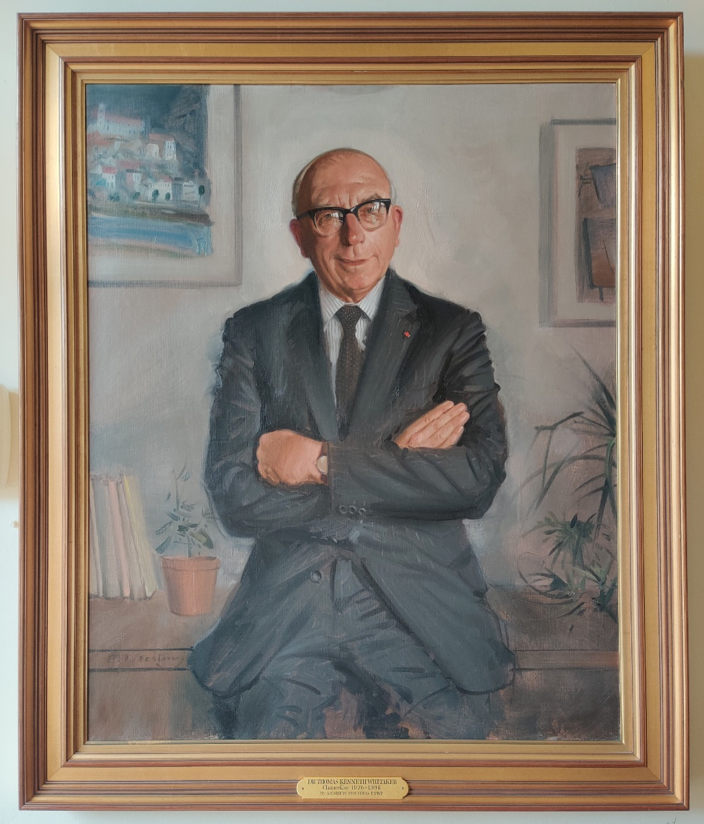
Thomas Kenneth Whitaker,
portrait by Andrew Festing
Clickto enlarge imageT K Whitaker, a native of Rostrevor, Co. Down, was born in 1916. Educated in Drogheda, he went on to study Economic Science at the University of London. By the age of 39, he was appointed secretary to the Department of Finance. Whitaker's vision as an economist culminated in the publication in 1958 of 'Economic Development' a study upon which the first programme for economic expansion in Ireland was built. This publication became known as the 'grey book' and marks a turning point in Irish economic history.
Whitaker's illustrious career spans a period of political, historical and educational change in Ireland: he arranged and attended the historic meeting at Stormont between Sean Lemass and Terence O'Neill in January 1965. In 1962, NUI conferred him with a DEconSc.
Whitaker was elected Chancellor by convocation on May 5th 1976, retaining this position until he resigned on December 31st 1996. Whitaker passed away on January 9th, 2017.
On 6th December 2016 NUI paid tribute to T.K. Whitaker on his 100th birthday.
Andrew Festing
Andrew Festing was born in 1941 in Northumberland, England. He served in the Rifle Brigade until 1969, at which point he began working for Sotheby’s, eventually heading the British Pictures Department. A member of the Royal Society of Portrait Painters, he was its president from 2002 until 2008. He has painted many important political figures in Britain, including the late Queen Elizabeth II of England. A prolific and beloved portrait painter, his entry on the Royal Society of Portrait Painters website notes that ‘Festing has painted some 750 portraits in the last 30 years’.
-
Garret Fitzgerald, portrait by Carey Clarke
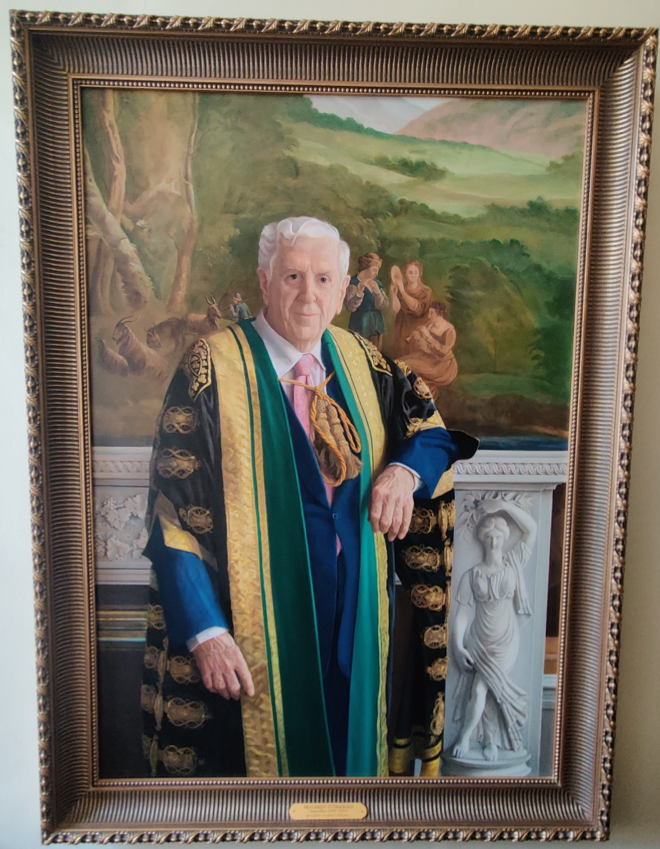
Garret Fitzgerald,
portrait by Carey Clarke
Click to enlarge image.Garret FitzGerald was born in Dublin in 1926. He obtained a BA (1946) and a PhD (1968) from University College Dublin and also graduated from Kings Inns, Dublin and was called to the Bar. Fitzgerald lectured in Economics at University College Dublin and in 1959 he was elected as the first chairman of the Irish Council of the European Movement.
He entered politics in 1965 upon his election to the National Senate and was subsequently elected to the Dáil in 1969. His political career has had many high points: he was the leading spokesman in favour of joining the EEC (82% voted yes) in the 1972 referendum; in 1973, he was appointed Foreign Minister in a new coalition Government; in 1975; in 1985 he successfully negotiated the Anglo-Irish Agreement with British Prime Minister, Margaret Thatcher, whereby the Irish Government secured an unprecedented role in relation to the protection of the interests of the Nationalist Community in Northern Ireland.
He was twice elected as Taoiseach - in 1981 for nine months and in 1983 for four and a half years. In 1987 he resigned as leader of the Fine Gael party, and in 1992 retired from the Dáil.
From 1997 to 2009, he was Chancellor of NUI and in 2011, he passed away.
In 2011, NUI instituted the Garret FitzGerald Memorial Lecture in his honour.
Carey Clarke
Carey Clarke was born in Donegal in 1936. He studied at the National College of Art and Design from 1954-59, going on to teach there for many years. In 1980, he joined the Royal Hibernian Academy and took on its presidency from 1992 to 1995. In Clarke’s illustrious career, he has painted former Taoiseach Albert Reynolds as well as Garret Fitzgerald. He most recently exhibited his portraiture work at the Royal Hibernian Academy in 2017.
-
Maurice Manning, portrait by James Hanley
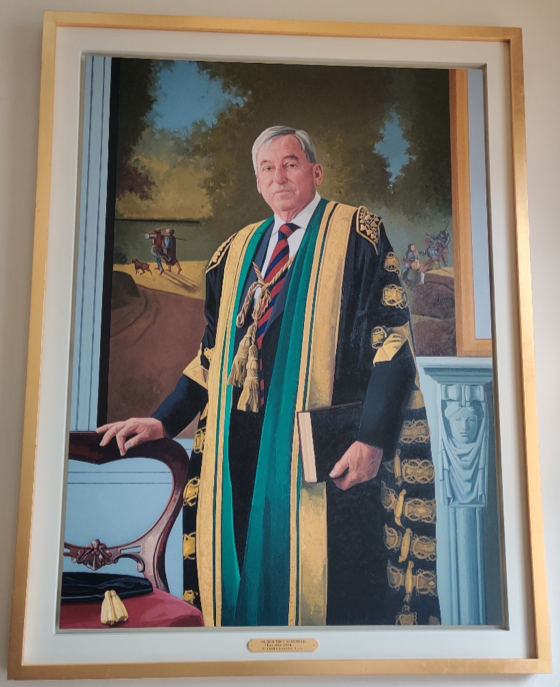
Maurice Manning,
portrait by James Hanley
Click to enlarge image.Maurice Manning, the current Chancellor of the National University of Ireland, was born in Carlow in 1943. An alumnus of University College Dublin and the University of Strathclyde, Manning went on to lecture in the Department of Politics in UCD. He has published widely and is currently Adjunct Professor in the School of Politics and International Relations at UCD.
He has been a member of the NUI Senate for twenty-seven years, having been elected on the graduate panel in every election since 1982. He is also currently Chair of the Publishing Committee of the Institute of Public Administration. Dr Manning has served in both Dáil and Seanad Éireann. In his political career, he has been a member of the New Ireland Forum and the British-Irish Inter-Parliamentary Body. He was president of the Irish Human Rights Commission for two terms, and has been elected to Seanad Éireann five times.
Most recently, he is chairman of the Expert Advisory Group on Centenary Commemorations. A group established in 2011 by the government to oversee the state programme of events to mark the Decade of Centenaries.
James Hanley
James Hanley, born 1965, is a graduate of both University College Dublin and the National College of Art & Design. A well-renowned portrait artist, he has painted former Taoiseach Bertie Ahern and former president Mary McAleese (also Carey Clarke, aforementioned above).
In 1996, he joined the Irish Defence Forces in Bosnia and Croatia in order to research for commissioned painting that would commemorate Ireland's presidency of the EC Monitoring Mission in the former Yugoslavia, which is now on display in the Military College at the Curragh Camp, Kildare.
In 2001, he became a member of the Royal Hibernian Academy. In 2008, he was elected to the Aosdána.
Bibliography:
- ‘Chancellors of the National University of Ireland.’ Chancellors of the NUI | National University of Ireland,
Accessed 16 Aug. 2023 - Morrissey, Thomas J. ‘Walsh, William Joseph.’ Walsh, William Joseph | Dictionary of Irish Biography,
Oct. 2009 - Doyle, Carmel. ‘Whelan, (Michael) Leo.’ Whelan, (Michael) Leo | Dictionary of Irish Biography,
Oct. 2009 - National Concert Hall. A Wonderful Painting by One of McCormack’s Closest Friends, Leo Whelan! Twitter,
10 Aug. 2022 - Ronan, Fanning. ‘De Valera, Éamon ('dev’).’ De Valera, Éamon ('Dev’) | Dictionary of Irish Biography,
Oct. 2009 . - ‘Thomas Ryan Obituary: A History Painter of Exceptional Talent.’ The Irish Times,
28 Oct. 2021. - Maume, Patrick.‘Fitzgerald, Garret.’ FitzGerald, Garret | Dictionary of Irish Biography,
Mar. 2021 - ‘RHA Gallery.’ Academicians Biography,
Accessed 16 Aug. 2023. - Aosdána,
Accessed 16 Aug. 2023.
« Previous






















